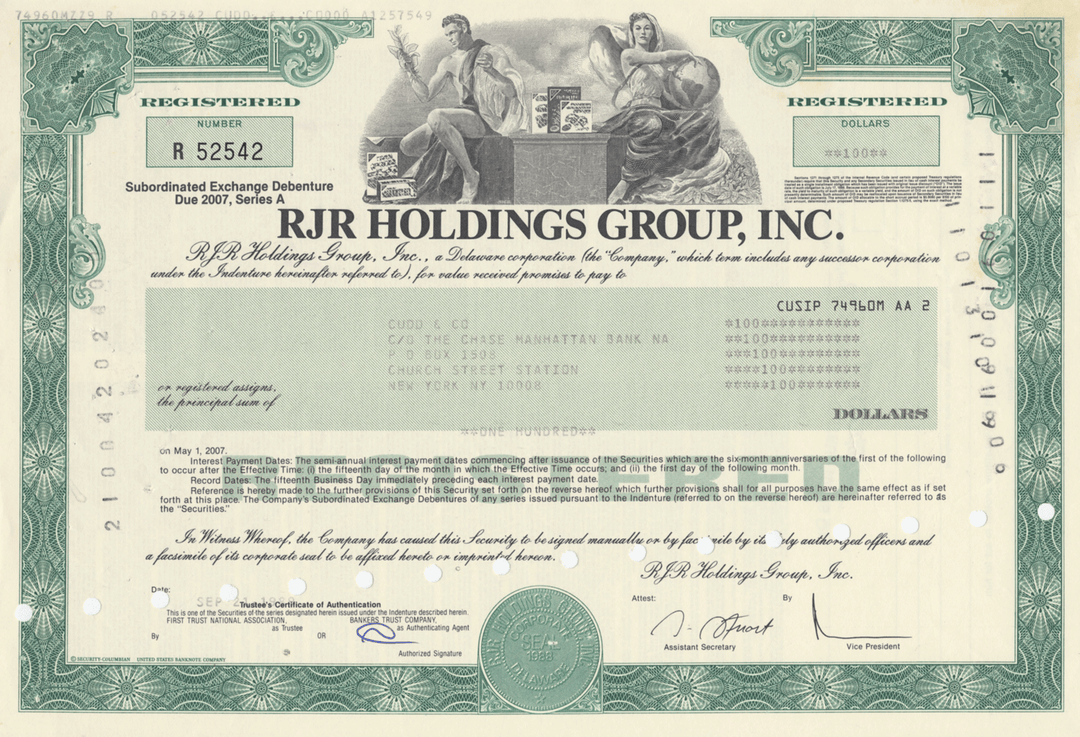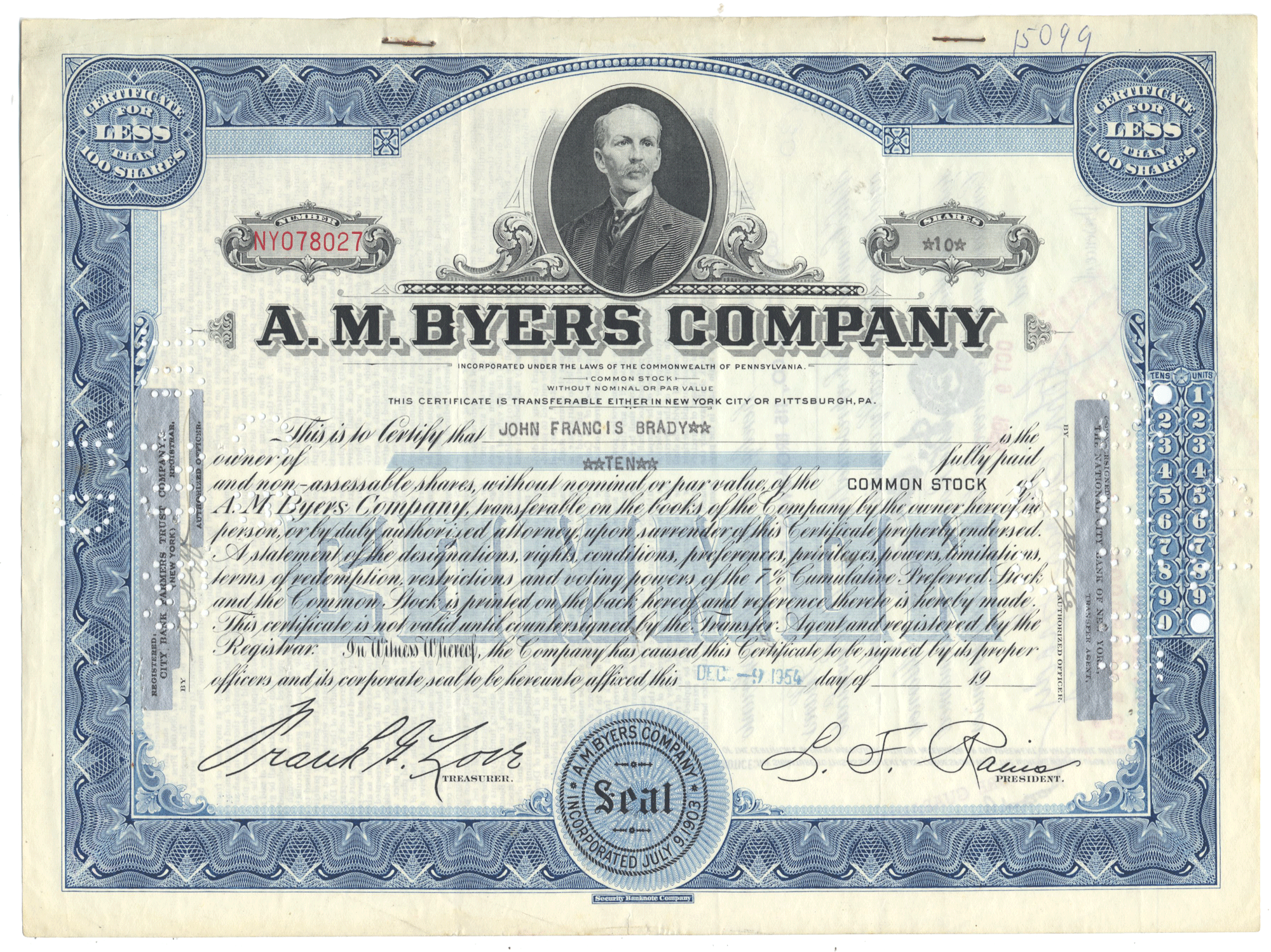
RJR Holdings Group, Inc. (Nabisco)
- Guaranteed authentic document
- Orders over $75 ship FREE to U. S. addresses
Product Details
CompanyRJR Holdings Group, Inc.
Certificate Type
Registered Bond
Date Issued
1980's
Canceled
Yes
Printer
Security-Columbian/United States Bank Note Company
Signatures
Machine printed
Approximate Size
12" (w) x 8" (h)
Images
Representative of the piece you will receive
Guaranteed Authentic
Yes
Additional Details
NA
Historical Context
In 1913, Reynolds Tobacco introduced Camel cigarettes, containing a blend of several different types of tobacco – a blend that would come to be called “the American blend.” Supported by a unique introductory “teaser” advertising campaign, Camel became the first nationally popular cigarette in the United States.
Reynolds Tobacco established virtually every packaging standard in the U.S. cigarette industry. The 20-cigarette pack was introduced by Reynolds Tobacco in 1913, and in 1915 the company introduced the one-piece, 10-pack carton. In 1931, Reynolds Tobacco became the first company to package its cigarettes with a moisture-proof, sealed cellophane outerwrap to preserve freshness.
In 1925, Brown & Williamson purchased J.G. Flynt Tobacco Co. and its trademarks, including the popular Sir Walter Raleigh smoking tobacco. The following year, the company bought R.P. Richardson Company, which had just started to market manufactured cigarettes.
On March 24, 1927, in Winston-Salem, North Carolina an announcement was made that Brown & Williamson was being acquired by London-based British American Tobacco p.l.c. (BAT) and reorganized as Brown & Williamson Tobacco Corporation. This enabled the company to increase its production capacity and expand its distribution beyond the Southeast. To expand its manufacturing capacity, construction began on a new Brown & Williamson factory in Louisville, Kentucky, in 1927. The company’s Winston-Salem office personnel relocated to Louisville in January 1929, and in 1931, the company’s executive offices in New York also moved to Louisville. Meanwhile, B&W’s first national brand, Raleigh, was launched as a premium cigarette in 1928.
In 1933, B&W launched KOOL cigarettes, the first U.S. menthol brand to gain nationwide distribution.
In 1936, B&W introduced Viceroy as the industry’s first cork-tipped filter product. In 1952, B&W began marketing Viceroy with a new “cellulose acetate” filter.
In 1954, Reynolds Tobacco introduced Winston – the first filter cigarette to achieve a major success in the marketplace.
Reynolds Tobacco introduced Salem – the first filter-tipped menthol cigarette, in 1956.
The Belair menthol brand was launched nationally by B&W in 1960.
The Doral brand was first introduced by Reynolds Tobacco in 1969. (It was repositioned and re-introduced in 1984.)
B&W introduced Barclay in 1980, as an ultra-low “tar” product featuring an “Actron” filter. In 1984, B&W acquired the marketing rights for GPC. In 1987, B&W introduced Capri, a stylish cigarette with a circumference of only 17 millimeters, the first “superslim” cigarette.
Reynolds Tobacco began diversifying into foods and other non-tobacco businesses in the 1960s. In 1970, the corporation formed a new parent company called R.J. Reynolds Industries, Inc.
In September 1985, Reynolds Industries acquired Nabisco Brands. In 1986, the parent company was re-named RJR Nabisco, Inc.
In November 1988, RJR Nabisco entered a merger agreement with Kohlberg Kravis Roberts & Co. (KKR) for the acquisition of RJR Nabisco by KKR. The merger was completed in April 1989. The acquisition was valued at $25 billion, marking the largest corporate transaction in history at that time. After being privately held for a period, the company’s common stock returned to the stock market in 1991. In early 1995, KKR divested its remaining holdings in RJR Nabisco.
As a result of BAT’s acquisition of American Tobacco Company in 1994, the Carlton, Pall Mall, Misty, Tareyton and Lucky Strike brands were added to the B&W brand family, as those operations were integrated into B&W in 1995.
Prior to 1999, RJR was a subsidiary of RJR Nabisco Holdings Corp. (RJRN). In 1999, following the sale of the company’s international tobacco business to Japan Tobacco, Inc., the remaining tobacco and food businesses were separated, and RJRN was renamed Nabisco Group Holdings Corp. (NGH).
On June 15, 1999, the former parent company, RJR Nabisco, Inc., was renamed R.J. Reynolds Tobacco Holdings, Inc., and became an independent, publicly traded company again, with R.J. Reynolds Tobacco Company as its wholly owned subsidiary. The separation was accomplished through a spin-off of the domestic tobacco business, on a tax-free basis in the United States, to RJR Nabisco’s stockholders. In a stock distribution on June 14, 1999, RJR Nabisco stockholders of record as of May 27, 1999, received one share of RJR for every three shares of RJR Nabisco they owned.
On December 11, 2000, R.J. Reynolds Tobacco Holdings, Inc. acquired its former parent company, Nabisco Group Holdings Corp., in a transaction that netted RJR $1.6 billion in cash.
On October 27, 2003, R.J. Reynolds Tobacco Holdings, Inc. and British American Tobacco p.l.c. announced that they had signed an agreement to combine the U.S. assets and operations of R.J. Reynolds Tobacco Company and Brown & Williamson Tobacco Corporation, the second- and third-largest tobacco companies in the United States.
On July 30, 2004, following approval by RJR shareholders and U.S. and European regulatory authorities, Reynolds American Inc. became the parent company of R.J. Reynolds Tobacco Company, Santa Fe Natural Tobacco Company and Lane Limited. On a combined 2003 basis, the company would have had annual revenues of approximately $8.4 billion, annual U.S. domestic cigarette volume of 119 billion units, and more than 30 percent of the cigarette sales in the United States.
In June 2015, R.J. Reynolds Tobacco Company brands Winston, Salem and Kool were sold to Imperial Tobacco Group, and Reynolds American Inc. acquired Lorillard Inc., with R.J. Reynolds Tobacco Company becoming the manufacturer of Newport.
Related Collections
Additional Information
Certificates carry no value on any of today's financial indexes and no transfer of ownership is implied. All items offered are collectible in nature only. So, you can frame them, but you can't cash them in!
All of our pieces are original - we do not sell reproductions. If you ever find out that one of our pieces is not authentic, you may return it for a full refund of the purchase price and any associated shipping charges.





